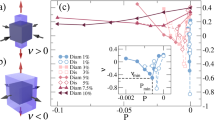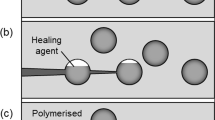Abstract
The resistance to fracture of reversible biopolymer hydrogels is an important control factor of the textural characteristics of food gels1 (such as gummy candies and aspic preparations). It is also critical for their use in tissue engineering, for which mechanical protection of encapsulated components is needed2,3. Its dependence on loading rate4 and, recently, on the density and strength of crosslinks3 has been investigated. But, so far, no attention has been paid to solvent or to environment effects. Here we report a systematic study of crack dynamics in gels of gelatin in water/glycerol mixtures. We show in this model system that increasing solvent viscosity slows down cracks; moreover soaking with solvent markedly increases gel fragility; finally tuning the viscosity by adding a miscible liquid affects crack propagation through diffusive invasion of the crack tip vicinity. The results highlight the fact that fracture occurs by viscoplastic chain pull-out. This mechanism, as well as the related phenomenology, should be common to all reversibly crosslinked (physical) gels.
This is a preview of subscription content, access via your institution
Access options
Subscribe to this journal
Receive 12 print issues and online access
$259.00 per year
only $21.58 per issue
Buy this article
- Purchase on Springer Link
- Instant access to full article PDF
Prices may be subject to local taxes which are calculated during checkout

 .
.


Similar content being viewed by others
References
Van Vliet, T. & Walstra, P. Large deformation and fracture behaviour of gels. Faraday Discuss. 101, 359–370 (1995).
Lee, K. Y. & Mooney, D. J. Hydrogels for tissue engineering. Chem. Rev. 101, 1869–1879 (2001).
Kong, H. J., Wong, E. & Mooney, D. J. Independent control of rigidity and toughness of polymeric hydrogels. Macromolecules 36, 4582–4588 (2003).
Mc Evoy, H., Ross-Murphy, S. B. & Clark, A. H. Large deformation and ultimate properties of biopolymer gels: 1. Single biopolymer component systems. Polymer 26, 1483–1492 (1985).
te Nijenhuis, K. Thermoreversible networks. Adv. Polym. Sci. 130, 160–193 (1997) Ch. 10.
Courty, S., Gornall, J. L. & Terentjev, E. M. Induced helicity in biopolymer networks under stress. Proc. Natl Acad. Sci. 102, 13457–13460 (2005).
Onuki, A. Theory of phase transition in polymer gels. Adv. Polym. Sci. 109, 63–121 (1993).
Johnson, D. L. Elastodynamics of gels. J. Chem. Phys. 77, 1531–1539 (1982).
Higgs, P. G. & Ross-Murphy, S. B. Creep measurements on gelatin gels. Int. J. Biol. Macromol. 12, 233–240 (1990).
Bonn, D., Kellay, H., Prochnow, M., Ben-Djemiaa, K. & Meunier, J. Delayed fracture of an inhomogeneous soft solid. Science 280, 265–267 (1998).
Lake, G. J. & Thomas, A. G. The strength of highly elastic materials. Proc. R. Soc. Lond. A 300, 108–119 (1967).
Nishinari, K., Koide, S. & Ogino, K. On the temperature dependence of elasticity of thermo-reversible gels. J. Physique 46, 793–797 (1985).
Higgs, P. G. & Ball, R. C. Some ideas concerning the elasticity of biopolymer networks. Macromolecules 22, 2432–2437 (1989).
Lawn, B. R. Fracture of Brittle Solids 2nd edn (Cambridge Univ. Press, Cambridge, 1993).
Hui, C.-Y., Jagota, A., Bennison, S. J. & Londono, J. D. Crack blunting and the strength of soft elastic solids. Proc. R. Soc. Lond. A 459, 1489–1516 (2003).
Tanaka, T., Hocker, L. O. & Benedek, G. B. Spectrum of light scattered from a viscoelastic gel. J. Chem. Phys. 59, 5151–5159 (1973).
Laurent, J.-L., Janmey, P. A. & Ferry, J. D. Dynamic viscoelastic properties of gelatin gels in glycerol-water mixtures. J. Rheol. 24, 87–97 (1980).
Baumberger, T., Caroli, C. & Ronsin, O. Self healing pulses and the friction of gelatin gels. Eur. Phys. J. E 11, 85–93 (2003).
Rivlin, R. S. & Thomas, A. G. Rupture of rubber. I. Characteristic energy for tearing. J. Polym. Sci. 10, 291–318 (1953).
Author information
Authors and Affiliations
Corresponding author
Ethics declarations
Competing interests
The authors declare no competing financial interests.
Rights and permissions
About this article
Cite this article
Baumberger, T., Caroli, C. & Martina, D. Solvent control of crack dynamics in a reversible hydrogel. Nature Mater 5, 552–555 (2006). https://doi.org/10.1038/nmat1666
Received:
Accepted:
Published:
Issue Date:
DOI: https://doi.org/10.1038/nmat1666
This article is cited by
-
A predictor for fatigue crack nucleation of single-network hydrogels considering water diffusion effect
International Journal of Fracture (2023)
-
Environmental control of crack propagation in polymer hydrogels
Mechanics of Soft Materials (2020)
-
Hydrogel as a Medium for Fluid-Driven Fracture Study
Experimental Mechanics (2017)
-
Solvent-free, supersoft and superelastic bottlebrush melts and networks
Nature Materials (2016)
-
Recent developments in dynamic fracture: some perspectives
International Journal of Fracture (2015)



